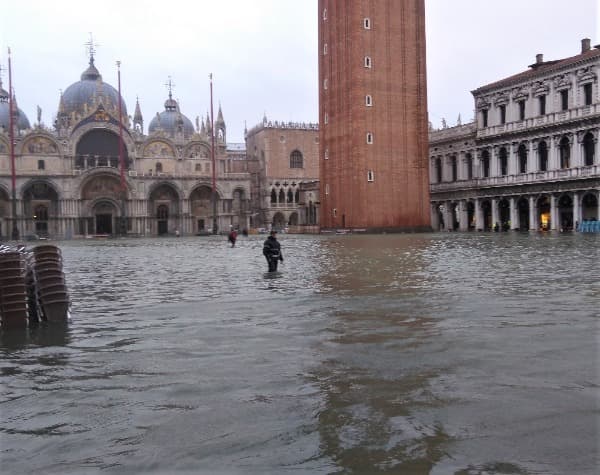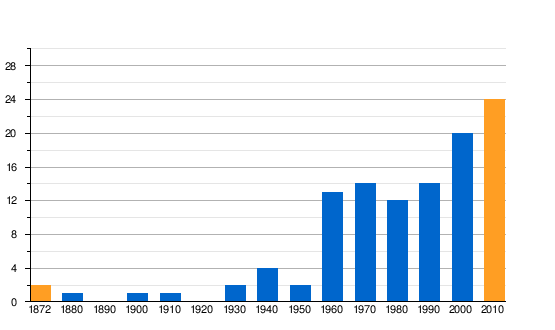The answer is yes, from a strictly objective point of view, Venice is sinking. But on the other hand, everything is sinking… More or less. Everything standing on the ground is affected by gravity, and gravity draws everything down. How much the ground is giving way depends on the resistance, and the mudd under Venice doesn’t have much of that.
And eventually, there is another phenomenon that comports a concrete threat that is more urgent than the soft soil underneath the city. There is another danger that could possibly result in Venice disappearing into the blue waves of the Mediterranean. But more about that later.
Subsidence – How fast is Venice sinking?
The ground gives way, but it’s a very slow process. On average, the soil on which Venice stands is 1,2 millimeters lower each year. But even if that’s not much, with years, decades, and centuries, it slowly builds up. But the city is about 1200 years old… 1200 years to sink into the mud. Still, she has survived and the streets and squares are still dry… Or at least mostly so.
A few years ago, the biggest problem was the high waters. It drenched the city at least a few times a year, with disasters in the form of economic loss of billions of euros, and destruction of priceless art throughout Venice.
For now, we are saved by the MOSE, the huge anti-flood system at the three inlets to the lagoon. It keeps us dry and has so far, kept every high water outside of the huge sluice gates. The menacing sea and the brutal waves slam against the yellow steel, while we, inside Venice’s old city, walk around in loafers.
Subsidence
The sinking of the ground is called subsidence, and the subsidence in Venice is more or less the same as in other comparable cities, 1,2 mm/year. The mud of the lagoon is not very hard, to say the least. It has less resistance than many other ground materials like rock or loam or even sand and silt. The river Po deposits sediment along the whole Po valley and it has done so for millions of years. The ground in this very big and very fertile part of northern Italy is similar. Cities like Padova, Mantova, and Piacenza stand on the same mud and they have similar subsidence. It is just that Venice barely keeps its head above the surface as it is, lying there in the middle of the lagoon. Sinking just a few centimeters is a much bigger issue in Venice than let’s say in Parma or Verona.
So subsidence of 1,2 mm is perfectly normal, compared to other places. But that wasn’t always the case…
A historical outlook on subsidence in Venice.
After WW2 the Harbor on the mainland, Porto Marghera, with its huge industrial area, expanded and new factories were constructed on a daily basis. For the construction and even more so for the production, they needed water. And the water was taken from the closest source, the soil. This lowered the level of the groundwaters and all of the surrounding lands paid the consequences. Venice started sinking together with everything around the lagoon. It was an unsustainable situation, and when the subsidence reached ten times the one we have today, someone had to do something about it. In 1969 it was 14 millimeters per year.
So new regulations were instituted and violations were prosecuted. Then new water pipelines were constructed, and Venice actually re-bounced. In 1975 the city rose almost 20 millimeters. After that, the subsidence stabilized. Although recent studies conducted by INGV suggest that natural subsidence could be as much as three times bigger than previously thought.
… But the sinking continues.
In the last hundred years, Venice has sunk 26 centimeters. This figure is based on the city compared to the sea surrounding her. To break that figure down, 6 cm is caused by natural subsidence, 8 cm by anthropic (man-made) subsidence, and 12 centimeters by the rising sea level. After 1970 the total sinking, subsidence, and rising sea level combined diminished. From about the mid-1990s, the rising sea levels are causing the total sinking to increase again.
This chart confirms the groundwater problem. The two cities follow hand in hand approximately until 1950. From 1950 til 1970, Venice creates a 10cm gap compared to Trieste… A gap she has kept until modern times. And those 10 cm are lost forever.
The Eustatism, the more dangerous threat…
The eustatism, the rising sea level. Globally this figure used to be 3,2 millimeters per year (NOAA), but according to the IPCC report of the 24th of September 2019, it’s now 4 mm/ year. In the Adriatic Sea, it’s a little less but when you think of it, it’s all really just one big bowl of water. If levels rise in the Atlantic and the Pacific it’s just a matter of time before the water flows into the Mediterranean. IPCC (Intergovernmental Panel on Climate Change) estimates a rise of sea level globally of between 0,3 and 1,1 meters by 2100, still according to the report 2019.09.24.
Well, at a 1,1 meter higher sea level…. it doesn’t really matter if Venice is sinking or not. It will be gone anyway.
In 1966 we had the highest high tide in the history of the city, the so-called Aqua Granda. The sea level reached 196 centimeters over the main sea level, wiped out most of the services, and caused immeasurable material damage to all of the territory. A new awareness of the vulnerability of the city started to grow among politicians locally and nationally. Something had to be done to protect this unique place with its fantastic palaces and millennial history for future generations. Because in the later years, the high water is becoming more frequent. In November 2019, in one week we had 4 of the 20 highest tides of all time with the peak on the 12th… 187cm. Is Venice sinking? It certainly looked like that the morning after.
And so a solution is at hand – MOSE.
After 30 years of various projects, drafts, and quarrels finally, in 2003, the MOSE was initiated. The name stands for Modulo Sperimentale Elettromeccanico, Experimental Electromechanical Module. It’s a huge project where enormous floodgates block the passage at the three inlets to the lagoon. In normal circumstances, they lie flat to the bottom but when the high tide sets in, air is pumped into the gates and they rise and close the straits.
They are in place now, and they have created a completely new environment for us, the Venetians, as well as for the millions of tourists. The dreaded high water is no more. To be more precise, the MOSE blocks the highest tides, those over 100 centimeters, more or less. But at that level, there are areas in Venice where you need waterproof footwear. Saint Mark’s Square is one such area. So you still need to pack your Gore-Tex shoes even though you can probably leave your rubber boots at home.
But still, having reached this point and looking back, it wasn’t a painless ride. It took more than 15 years and endless discussions, negotiations, sacrifices, and even the indictment of high-rank politicians. We passed through a dark tunnel of corruption and politicians and industrialists holding hands… The money was floating out of the project like water through a colander.
The MOSE scandal in 2014.
In February 2013 the first arrest took place, followed by another 50 or so in the year and a half that followed. Among them, many top-level politicians and public administrators.
- The Venice Major Giorgio Orsoni had to resign in 2014 all because of this. He was sentenced to 4 months in house arrest but acquitted in 2017, although three cases of confirmed bribery had exceeded the limitation period.
- Giancarlo Galan, the ex-president of the Veneto region, was sentenced to 2 years and 10 months in prison. He was also sentenced to pay back € 5,8 million of a total of € 15 million embezzled. As of 2021, the Italian Court of Auditors confirmed that Galan had paid a total of € 1,800 of the € 5.2 million he owes.
- Renato Chisso, ex-Regional Councilor for Mobility and the Environment was sentenced to 2 and a half years in prison. That sentence was later suspended, but he was to pay back a total of € 2 million. Only a small portion of that has been recovered. In 2022 Chisso was sentenced again. This time he was sentenced to pay back € 332.287 in unjustified disbursement.
- The total expense of corruption and bribes in the MOSE scandal amounted to € 58 million.
After that, the whole project was almost at a complete standstill. Then ANAC, the Italian National Anti-corruption Authority took over the management, but at that time, the lack of financing and maybe the lack of confidence among politicians and finances alike stopped the progress. But stopping such a technically advanced project with so many moving parts embedded at the bottom of a soft, muddy, and very rich environment wasn’t a smart move. Soon the algae, the clams, and all the other living things down there threatened to reclaim the steel gates. Very soon, the extremely expensive mechanics lying motionless there on the muddy seabed were full of sludge and mud.
So, before they could go ahead and finish the project, they had to complete maintenance for many millions of euros, and that slowed it down further. At a certain point, ANAC claimed that cleaning one of the sluice gates from all the vegetation and dirt would cost 1,5 million euros while buying a new one would cost 1 million. There’s a sustainable society for you…
It’s funny to read the following phrase on the official site of the MOSE project:
The Mose can protect Venice and the lagoon from tides up to 3 meters high and from a rise in sea level up to 60 centimeters in the next 100 years.
Still referring to the latest report from the IPCC of the 24th of September, The whole project could be outdated in fifty years.
From a disaster to the salvation of Venice
After a few years of sleepless nights, ANAS and the Italian government finally got their act together. Following the nomination of a few crucial and very competent persons in leading roles, the whole project finally was completed in 2020. The season of 2020 was supposed to be just a test period with occasional activations. It wasn’t supposed to be fully operational until autumn 2021. But since the autumn of 2020, Venice has not suffered any flooding at all.
The first time the whole barrier was raised was on the 10th of July 2020. 78 gates were raised together completely blocking the inlets. It was a beautiful summer day with sunny, warm weather. Very different from the winter storms rolling in in December, but still. On-site there were many representatives from the government as well as local politicians, Prime Minister Giuseppe Conte, Interior Minister Luciana Lamorgese, and Minister for Infrastructure Paola De Micheli.
To conclude:
Venice will face many challenges in the decades to come. Some of them we can overcome with a bit of hard work while others are more difficult. Of all the threats to the existence of La Serenissima, the rising sea level is the greatest. Because if the foreboding of the Intergovernmental Panel on Climate Change (IPCC) comes true then no MOSE can save Venice.
They talk about a possible 1 meter higher sea levels at the end of this century. And at 1 meter Venice will disappear. To say that these predictions are uncertain would be an understatement, but IPCC bases its conclusions on the best information we have. And they consist of some of the most competent and unbiased scientists in the world. So, what they claim should be taken seriously, and not be dismissed.
Certain parts of the world are much more vulnerable than other parts. Tropical island states, very low coastal regions, and of course, extreme cities like Venice will suffer the most. And some of these areas would disappear, MOSE or no MOSE.
So, of all the challenges Venice will have to face in the future, the rising sea levels are by far the biggest threat.




